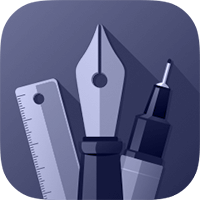Rotating Objects
Choose the Rotate tool to rotate objects around a reference point.
To rotate one or more objects, first select the objects to be rotated and choose the Rotate tool. With the Rotate tool active, click and drag anywhere on the canvas to rotate the objects clockwise or counterclockwise.
To constrain the rotation to 15˚ increments, hold the Shift ⇧ key while dragging.
Tip: Use the R keyboard shortcut to quickly select the Rotate tool.
Objects can be rotated numerically using the Tool Options bar. Set a rotation angle in the field and click Rotate to apply the rotation. Clicking Copy will duplicate the objects first and then apply the rotation to the copied objects.
Alternatively, objects can be rotated numerically using the Rotation settings from the Geometry pane of the Properties panel.
By default, the reference point will be located in the center of the selected objects. To use a different location for the reference point, click-and-drag it to set it at that new location.
Objects can also be rotated manually using Move tool's bounding box.
Choose the Move tool and make a selection. Moving the mouse pointer slightly outside of a bounding box handle will change the cursor to a curve with arrows at each end. Clicking and dragging in this mode will rotate the selected objects.
Holding down the Shift ⇧ key while rotating will constrain the rotation to 15˚ increments.
Finally, you can choose Modify > Rotate and Transform > Rotate 90˚Clockwise from the menu bar to rotate the selection 90˚clockwise or Modify > Rotate and Transform > Rotate 90˚Counter-Clockwise to rotate the selection 90˚counter-clockwise.
Next: Scaling Objects >


